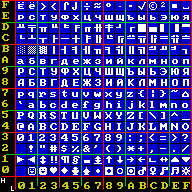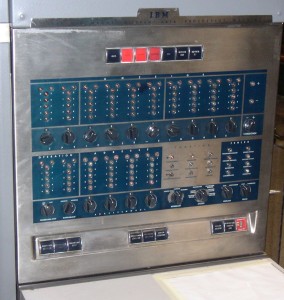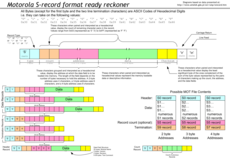In mathematics and computing, the hexadecimal numeral system is a positional numeral system that represents numbers using a radix (base) of sixteen. Unlike the decimal system representing numbers using ten symbols, hexadecimal uses sixteen distinct symbols, most often the symbols "0"–"9" to represent values 0 to 9, and "A"–"F" to represent values from ten to fifteen.

In computing, a nibble (occasionally nybble, nyble, or nybl to match the spelling of byte) is a four-bit aggregation, or half an octet. It is also known as half-byte or tetrade. In a networking or telecommunication context, the nibble is often called a semi-octet, quadbit, or quartet. A nibble has sixteen (24) possible values. A nibble can be represented by a single hexadecimal digit (0–F) and called a hex digit.
UTF-8 is a variable-length character encoding standard used for electronic communication. Defined by the Unicode Standard, the name is derived from Unicode Transformation Format – 8-bit.

UTF-16 (16-bit Unicode Transformation Format) is a character encoding capable of encoding all 1,112,064 valid code points of Unicode (in fact this number of code points is dictated by the design of UTF-16). The encoding is variable-length, as code points are encoded with one or two 16-bit code units. UTF-16 arose from an earlier obsolete fixed-width 16-bit encoding, now known as UCS-2 (for 2-byte Universal Character Set), once it became clear that more than 216 (65,536) code points were needed.
In computing, endianness is the order or sequence of bytes of a word of digital data in computer memory or data communication which is identified by describing the impact of the "first" bytes, meaning at the smallest address or sent first. Endianness is primarily expressed as big-endian (BE) or little-endian (LE). A big-endian system stores the most significant byte of a word at the smallest memory address and the least significant byte at the largest. A little-endian system, in contrast, stores the least-significant byte at the smallest address. Bi-endianness is a feature supported by numerous computer architectures that feature switchable endianness in data fetches and stores or for instruction fetches. Other orderings are generically called middle-endian or mixed-endian.

The KIM-1, short for Keyboard Input Monitor, is a small 6502-based single-board computer developed and produced by MOS Technology, Inc. and launched in 1976. It was very successful in that period, due to its low price and easy-access expandability.
In computing, tar is a computer software utility for collecting many files into one archive file, often referred to as a tarball, for distribution or backup purposes. The name is derived from "tape archive", as it was originally developed to write data to sequential I/O devices with no file system of their own. The archive data sets created by tar contain various file system parameters, such as name, timestamps, ownership, file-access permissions, and directory organization. POSIX abandoned tar in favor of pax, yet tar sees continued widespread use.
In computer programming, Base64 is a group of tetrasexagesimal binary-to-text encoding schemes that represent binary data in sequences of 24 bits that can be represented by four 6-bit Base64 digits.
In computer programming, a magic number is any of the following:
Modbus or MODBUS is a client/server data communications protocol in the application layer of the OSI model. It was originally published by Modicon in 1979 for use with its programmable logic controllers (PLCs). Modbus has become a de facto standard communication protocol for communication between industrial electronic devices in a wide range of buses and network.
BinHex, originally short for "binary-to-hexadecimal", is a binary-to-text encoding system that was used on the classic Mac OS for sending binary files through e-mail. Originally a hexadecimal encoding, subsequent versions of BinHex are more similar to uuencode, but combined both "forks" of the Mac file system together along with extended file information. BinHexed files take up more space than the original files, but will not be corrupted by non-"8-bit clean" software.
A hex editor is a computer program that allows for manipulation of the fundamental binary data that constitutes a computer file. The name 'hex' comes from 'hexadecimal', a standard numerical format for representing binary data. A typical computer file occupies multiple areas on the storage medium, whose contents are combined to form the file. Hex editors that are designed to parse and edit sector data from the physical segments of floppy or hard disks are sometimes called sector editors or disk editors.
Netpbm is an open-source package of graphics programs and a programming library. It is used mainly in the Unix world, where one can find it included in all major open-source operating system distributions, but also works on Microsoft Windows, macOS, and other operating systems.
Intel hexadecimal object file format, Intel hex format or Intellec Hex is a file format that conveys binary information in ASCII text form, making it possible to store on non-binary media such as paper tape, punch cards, etc., to display on text terminals or be printed on line-oriented printers. The format is commonly used for programming microcontrollers, EPROMs, and other types of programmable logic devices and hardware emulators. In a typical application, a compiler or assembler converts a program's source code to machine code and outputs it into a HEX file. Some also use it as a container format holding packets of stream data. Common file extensions used for the resulting files are .HEX or .H86. The HEX file is then read by a programmer to write the machine code into a PROM or is transferred to the target system for loading and execution.

Decimal computers are computers which can represent numbers and addresses in decimal as well as providing instructions to operate on those numbers and addresses directly in decimal, without conversion to a pure binary representation. Some also had a variable wordlength, which enabled operations on numbers with a large number of digits.
Tektronix hex format and Extended Tektronix hex format / Extended Tektronix Object Format are ASCII-based hexadecimal file formats, created by Tektronix, for conveying binary information for applications like programming microcontrollers, EPROMs, and other kinds of chips.

The ZX Spectrum character set is the variant of ASCII used in the ZX Spectrum family computers. It is based on ASCII-1967 but the characters ^, ` and DEL are replaced with ↑, £ and ©. It also differs in its use of the C0 control codes other than the common BS and CR, and it makes use of the 128 high-bit characters beyond the ASCII range. The ZX Spectrum's main set of printable characters and system font are also used by the Jupiter Ace computer.
Escape sequences are used in the programming languages C and C++, and their design was copied in many other languages such as Java, PHP, C#, etc. An escape sequence is a sequence of characters that does not represent itself when used inside a character or string literal, but is translated into another character or a sequence of characters that may be difficult or impossible to represent directly.
The FAT file system is a file system used on MS-DOS and Windows 9x family of operating systems. It continues to be used on mobile devices and embedded systems, and thus is a well suited file system for data exchange between computers and devices of almost any type and age from 1981 through the present.
The MOS Technology file format is a file format that conveys binary information in ASCII text form.





